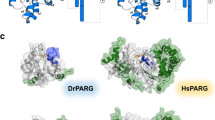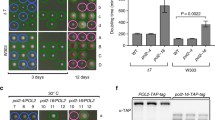Summary
Constitutive expression of human nuclear NAD+: protein ADP-ribosyltransferase (polymerizing) [pADPRT; poly(ADP-ribose)polymerase; EC 2.4.2.30] as an active enzyme in Saccharomyces cerevisiae, under the control of the alcohol dehydrogenase promoter, was only possible with simultaneous inhibition of ADP-ribosylation by 3-methoxybenzamide. Induction of fully active pADPRT from the inducible galactose epimerase promoter resulted in inhibition of cell division and morphological changes reminiscent of cell cycle mutants. Expression of a pADPRT cDNA truncated at its 5′end had no influence on cell proliferation at all. Obviously the amino-terminal part of the DNA binding domain containing the first “zinc finger”, which is essential for inducibility of pADPRT activity by DNA breaks, is also required for inhibition of cell growth on expression in yeast. Full-length as well as truncated pADPRT molecules were directed to the cell nucleus where the fully active enzyme produced large amounts of poly(ADP-ribose) by automodification. Since pADPRT turned out to be the only target for ADP-ribosylation in these cells, elevated levels of poly(ADP-ribose) were the most likely cause of inhibition of cell division, presumably resulting from interaction with chromosomal proteins.
Similar content being viewed by others
References
Alkhatib HM, Chen D, Cherney B, Bhatia K, Notario V, Giri C, Stein G, Slattery E, Roeder RG, Smulson ME (1987) Cloning and expression of cDNA for human poly(ADP-ribose) polymerase. Proc Natl Acad Sci USA 84:1224–1228
Althaus FR, Richter C (1987) ADP-ribosylation of proteins. Mol Biol Biochem Biophys 37:1–122
Althaus FR, Bachmann S, Braun SA, Collinge MA, Höfferer L, Malanga M, Panzeter PL, Realini C, Richard MC, Waser S, Zweifel B (1991) The poly(ADP-ribose)-protein shuttle of chromatin. In: Poirier GG, Moreau P (eds) ADP-ribosylation reactions. Springer New York, in press
Ammerer G (1983) Expression of genes in yeast using the ADC1 promoter. Methods Enzymol 101:192–201
Auer B, Nagl U, Herzog H, Schneider R, Schweiger M (1989) Human nuclear NAD+ ADP-ribosyltransferase(polymerizing): Organization of the gene. DNA 8:575–580
Burtscher HJ, Auer B, Klocker H, Schweiger M, Hirsch-Kauffman M (1986) Isolation of ADP-ribosyltransferase by affinity chromatography. Anal Biochem 152:285–290
Cooper TG (1982) Nitrogen metabolism in Saccharomyces cerevisiae. In: Strathern JN, Jones EW, Broach JR (eds) Molecular biology of the yeast Saccharomyces; Metabolism and gene expression. Cold Spring Harbor Laboratory Press, Cold Spring Harbor, New York, pp 39–99
Hartwell LH, Culotti J, Pringle JR, Reid BJ (1974) Genetic control of the cell division cycle in yeast. Science 183:46–51
Herzog H, Zabel BU, Schneider R, Auer B, Hirsch-Kauffmann M, Schweiger M (1989) Human nuclear NAD+ ADP-ribosyltransferase: Localization of the gene on chromosome 1q41–q42 and expression of an active human enzyme in Escherichia coli. Proc Natl Acad Sci USA 86:3514–3518
Hill JE, Myers AM, Koerner TJ, Tzagoloff A (1986) Yeast/E. coli shuttle vectors with multiple unique restriction sites. Yeast 2:163–167
Ito H, Fukuda Y, Murata K, Kimura A (1983) Transformation of intact yeast cells treated with alkali cations. J Bacteriol 153:163–168
Johnson PF, Abelson J (1983) The yeast tRNATyr gene intron is essential for correct modification of its tRNA product. Nature 302:681–687
Johnston M, Davis R (1984) Sequences that regulate the divergent GAL1-GAL10 promoter in Saccharomyces cerevisiae. Mol Cell Biol 4:1440–1448
Kameshita I, Matsuda Z, Tanigchi T, Shizuta Y (1984) Poly(ADP-ribose)synthetase. Separation and identification of three proteolytic fragments as the substrate-binding domain, the DNA-binding domain and the automodification domain. J Biol Chem 259:4770–4776
Kawamitsu H, Hoshino H, Okada H, Miwa M, Momoi H, Sugimura T (1984) Monoclonal antibodies to poly(adenosine diphosphate ribose) recognize different structures. Biochemistry 23:3771–3777
Klocker H, Auer B, Hirsch-Kauffmann M, Altmann H, Burtscher HJ, Schweiger M (1983) DNA repair-dependent NAD1+ metabolism is impaired in cells from patients with Fanconi's anemia. EMBO J 2:303–307
Kozak M (1989) The scanning model for translation: an update. J Cell Biol 108:229–241
Kurosaki T, Ushiro H, Mitsuuchi Y, Suzuki S, Matsuda M, Katanuma N, Kangawa K, Matsuo H, Hirose T, Inayama S, Shizuta H (1987) Primary structure of human poly(ADP-ribose)synthetase as deduced from cDNA sequence. J Biol Chem 262:15990–15997
Maniatis T, Fritsch EF, Sambrook J (1982) Molecular cloning: A laboratory manual. Cold Spring Harbor Laboratory Press, Cold Spring Harbor, New York
Ménissier-deMurcia J, Schreiber V, Molinete M, deMurcia G (1991) Nuclear targeting sequence of human poly(ADP-ribose) polymerase. In: Poirier GG, Moreau P (eds) ADP-ribosylation reactions. Springer New York, in press
Pringle JR, Adams AEM, Drubin DG, Haarer BK (1991) Immunofluorescence methods for yeast. Methods Enzymol 194:565–602
Rankin PW, Jacobson EL, Benjamin RC, Moss J, Jacobson MK (1989) Quantitative studies of inhibitors of ADP-ribosylation in vitro and in vivo. J Biol Chem 264:4312–4317
Schneider R, Auer B, Kühne C, Herzog H, Klocker H, Burtscher HJ, Hirsch-Kauffmann M, Wintersberger U, Schweiger M (1987) Isolation of a cDNA clone for human NAD+: protein ADP-ribosyltransferase. Eur J Cell Biol 44:302–307
Scovassi AI, Stefanini M, Bertazzoni U (1984) Catalytic activities of human poly(ADP-ribose) polymerase from normal and mutagenized cells detected after sodium dodecyl sulfate polyacrylamide gel electrophoresis. J Biol Chem 259:10973–10977
Torchia TE, Hamilton RW, Cano CL, Hopper JE (1984) Disruption of regulatory gene GAL80 in Saccharomyces cerevisiae: effects on carbon-controlled regulation of the galactose/melibiose pathway genes. Mol Cell Biol 4:1521–1527
Uchida K, Morita T, Sato T, Ogura T, Yamashita R, Noguchi S, Suzuki H, Nyunoya H, Miwa M, Sugimura T (1987) Nucleotide sequence of a full-length cDNA for human fibroblast poly(ADP-ribose)-polymerase. Biochem Biophys Res Commun 148:617–622
Yanisch-Perron C, Vieira J, Messing J (1985) Improved M13 phage cloning vectors and host strains: nucleotide sequences of the M13mp18 and pUC19 vectors. Gene 33:103–119
Yocum RR, Hanley S, West R, Ptashne M (1984) Use of lacZ fusions to delimit regulatory elements of the inducible divergent GAL1-GAL10 promoter in Saccharomyces cerevisiae. Mol Cell Biol 4:1985–1998
Author information
Authors and Affiliations
Additional information
Communicated by E. Bautz
Rights and permissions
About this article
Cite this article
Kaiser, P., Auer, B. & Schweiger, M. Inhibition of cell proliferation in Saccharomyces cerevisiae by expression of human NAD+ ADP-ribosyltransferase requires the DNA binding domain (“zinc fingers”). Molec. Gen. Genet. 232, 231–239 (1992). https://doi.org/10.1007/BF00280001
Received:
Issue Date:
DOI: https://doi.org/10.1007/BF00280001




